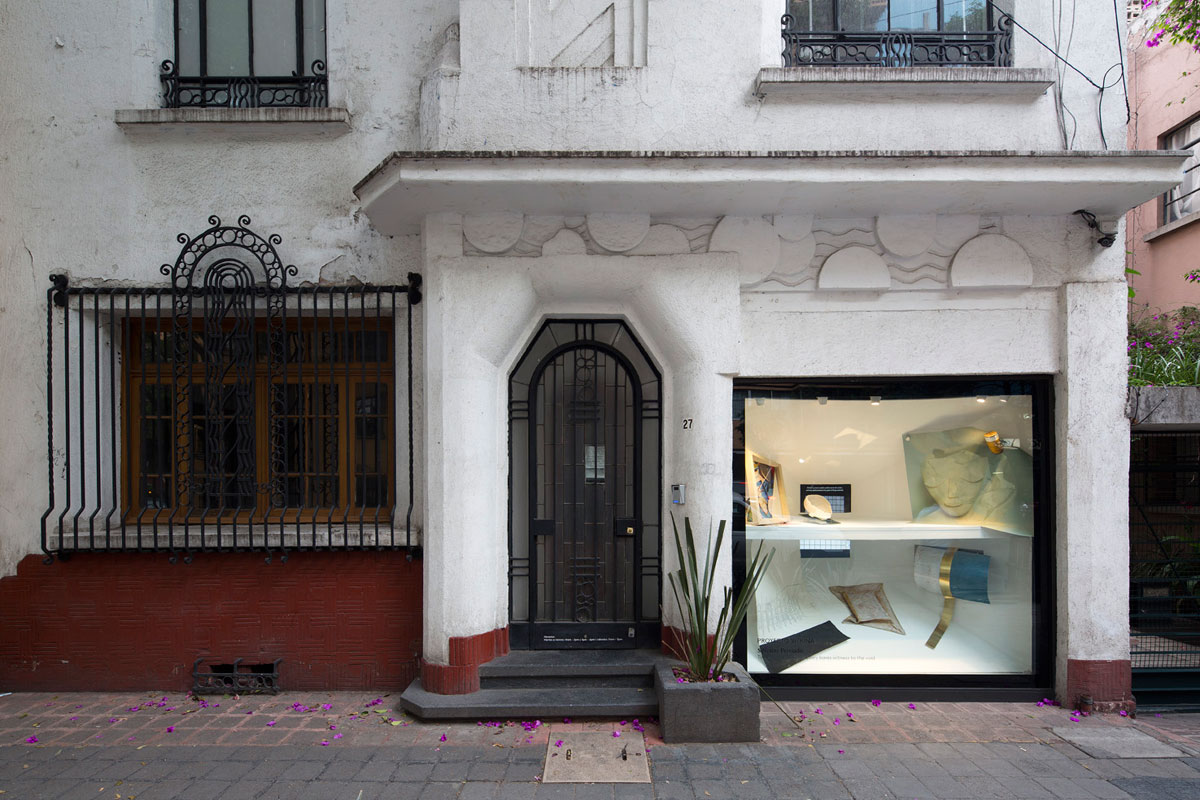Proyecto Vitrina
Timely bones: the reliquary bares witness to the void
Silvestre Preciado
 Installation view. 2016
Installation view. 2016Instances of nihilism and martyrdom are recorded throughout history within societies irrespective of culture. Their objectivity is fueled by the disillusionment of their current worlds.
Today, neither exists as a profound spiritual act or realization, but as a traceable collective cleansing pandemic of human moral preservation. Nihilism and martyrdom are notions embedded within the human psyche, and are, as such paradoxically active in the preservation of their understanding of a moral good.
This vitrine installation features nine sculptures and two separate but simultaneously paired videos within a forced perspective structure. The structure comprises white sheetrock paneling angled toward a central single-point perspective – the meeting point of the vertical video screens.
These video screens tell the visual narrative of out-sourced cellphone documentation, capturing a variety of point A to point B commutes. This reveals no true journey, rather, one that ends with a void – a nihilistic journey upon which humanity (individual and collective) perennially embarks. The video is narrated as a reference to the Russian novel Fathers and Sons by Ivan Turgenev, in which the son advocates his university-fostered nihilistic views to his father. The installation’s video is narrated as is a dialogue between a mother and her son. However, rather than the son extolling the legitimacies of his nihilistic sympathies, the roles are reversed, the mother instead introduces her son to existentialist philosophies – Consciousness is an accident of evolution, consciousness interrupts truth and humanities essential journey to the void - He realizes the inevitability of his death; only then is he truly alive.
The nine sculptures featured within the vitrine sit as a variation on the materialistic components that typify traditional martyr shrines traceable in the reliquary history of both Eastern and Western cultures.
From continent to continent, such shrines vary hugely in scale, materiality, and ideology. Stylistic adornments are often in the form of kitsch household objects, which is at odds with the heavy spiritual meaning that is imposed on them.
In contrast to a grave site, the inanimate objects in a martyr shrine do not represent the deceased individual. Their sole function is to uphold the memory of the deceased’s act of sacrifice for a political or religious ideology. Furthermore, the shrine side-steps the individual all together, sanctioning the shrine for political and religious ideological motivation.
The nihilist and the martyr are not only representative of a sacrifice made for an ideology, but also a sacrifice of a self-imposed ideology that negates, or opposes its own culture. This is when the body is employed as a protest. The body does not lie, the action of the body is truth. This employment of the body is strictly and perpetually embedded in the reliquary’s materials and object-hood. My appropriation of these objects within the installation serves to challenge the possibility that the objects are indefinitely rendered more important than the lives sacrificed.
Due to the emotional bondage to human servitude that these objects bare; The exhibition seeks to alter their material condition as new post-servitude objects by providing them with a meaningless site to rest – the vitrine. The objects lose their connection to humans via their memorializing function, and may either return to their commodified definition, or are rendered alien to the viewer’s initial glance. As a result of their intentional encasement within the vitrine, the installation requires the spectator to activate a new virtual narrative.
The creation of this installation within a vitrine is a reference to Duchamp’s The Large Glass. Employing a DADA vernacular, Duchamp alludes to the void which characterises the spectator's need to crack open the vitrine in order to consummate desire, only to find that desire to be death itself or the void. Behind the vitrine window is the void that is constantly advertised and propagated to us as desire.
Ultimately, the spectator’s role is to uncover the inanimate objects' imposed cultural mythos, in order to reveal new aspects of their virtual selves and the cultural models that they both inhabit. Here, the reliquary bears witness to the spectator's societal finitude.
– Silvestre Preciado
PROYECTO VITRINA works as a showcase of collaborative projects between diverse artists and Arredondo \ Arozarena gallery. It is on view at Praga Street in Colonia Juarez, Mexico City.